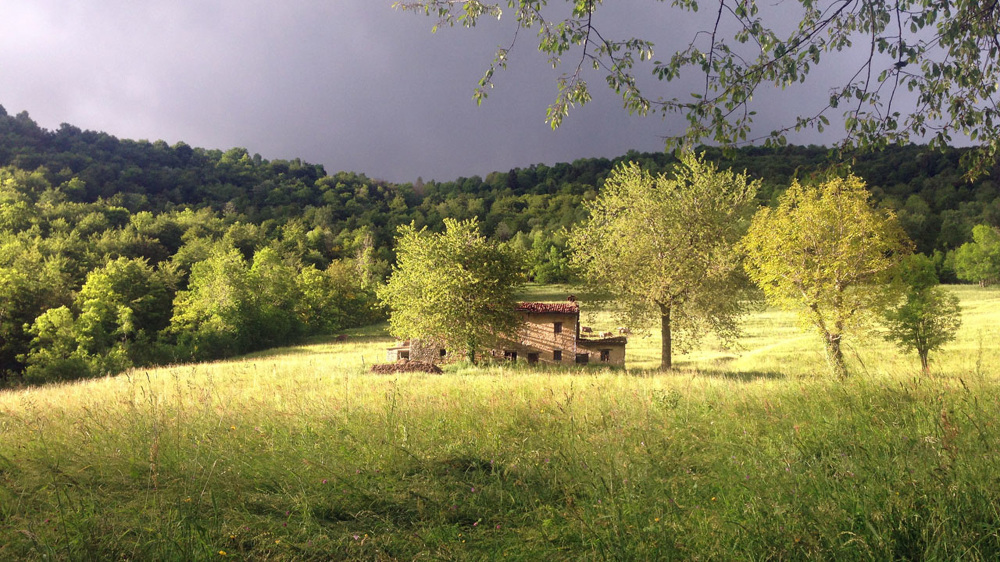Duration: 4 weeks, June 2017
Artist Accommodation: Provided. Studio or One Bedroom Apartment (one per each artist). Shared studio areas and open-air studio space provided upon request.
Number of artists resident at one time: Between 5 and 7.
Application deadline: February 5, 2017
How to apply: http://cargocollective.com/nahr/Apply-1
[== LINK ==]
Set in the rural Taleggio Valley in northern Italy, the NAHR program offers a lively space to productively think and create, collaborate and interact, and our residents take full advantage of the surrounding natural landscapes as well as Italy’s rich material culture, which combines vernacular traditions with innovative approaches to space and place, people and their communities.
NAHR is a one-month residency (June) offered to six multidisciplinary professionals and one university level student active in the fields of bio-inspired arts, design, architecture, as well as anthropology, botany, natural sciences, literature, technology, economy or a cross-disciplinary blend of any of these. An international jury will select the residents based on their proposals. Selection criteria will include feasibility, originality, and overall quality of the proposals. Each NAHR residency is supplied without fees; lodging is provided.
Residencies will be awarded according to independent project proposals that best explore the 2017 topic Rock and stone: material culture and cultures of making; candidates are asked to consider how their proposals might best explore how to build dynamic relationships and articulations between the Valley’s ecological resources, socio-cultural practices, and the built environment.
Proposals will consider the Taleggio Valley as a case study and will understand the residency is an opportunity to develop individual research paths. Proposals must aim to explore in-depth the domains of nature and landscape alongside the identity and memory of the valley situated in the heart of the Orobie Alps. Approaches may include the tangible and intangible heritage of rural buildings, artifacts, works, as well as oral stories, knowledge, know-how, traditions, crafts, flavors, habits of the local population and communities that participate, legitimize, perpetuate, and generate an in situ cultural logic of people and place.
Selection priority will be given to proposals that demonstrate both a direct engagement with the surrounding nature and the human habitat, through objectives and methods, and the ability to produce an artifact such as an installation, a thematic path, a sculpture, paintings, texts, food recipes, as new types of landmark on the Valley’s territory.
Applicants need to demonstrate via their portfolio a strong commitment to research and investigation, as well as demonstrate the production of previous work relating to the scope of NAHR. Proposals will include a description of how the Taleggio Valley can be the appropriate case study for ongoing work.
NAHR’s multidisciplinary laboratory propels innovative and creative thinking. Annually dedicating research toward a specific natural element so as to examine the resiliency of the ecological systems located in Taleggio Valley, NAHR is pleased to launch the 2017 summer residency, entitled Rock and Stone: Material Culture and Cultures of Making.
Rock represents the substrate of life, and gives shapes to the natural landscape, conferring character to vernacular built environments. Rock has been used for human tools, and the tradition of shaping and sculpting rocks continues today. Rock is also used to create concrete, that most common of construction materials, and it is at the basis of silicon that gives substance to the hi-tech world, a paradigm shift to mark the onset of the current Anthropocene geological age.
Revealing connections between the natural and artificial, rock is both a repository of the geological past as well as a material that shapes our future.
NAHR’s 2017 theme will explore the material that also constitutes the foundations of the Taleggio Valley. Omnipresent at different scales – from the monumental mountains to the sedimented minerals, from the historical traditional architecture to structural details and small handmade objects – the presence of rock can initiate material and poetical explorations to inspire and encourage creative design actions.
Visits to quarries, walks to the mountain peaks, dedicated lectures by specialists will guide the observation and analysis of the rock surrounding NAHR, and this summer’s residency program expects to explore interactions and relationships within the valley’s ecosystem by offering site-specific investigations and opening up the possibility of a range of inter- and cross-disciplinary research opportunities.
NAHR is particularly invested in expressing the resiliency of nature in four domains:
Regenerative Economy:
Encourages the study of local culture and production/exchange relations extending to observations on local ecosystems in order to generate economic models based on concepts of restoration, regeneration and circularity. These models are ideally exportable to future developments at both local and global scales, promoting a resilient use of natural and cultural resources, eliminating obsolete concepts such as waste and pollution.
Bio-Inspired Design and Architecture:
Development and/or creation of projects and artifacts inspired by form, functions and processes found in the nature of the Valley.
Body Performing Nature:
Artworks production and critical investigations that embody relationships to nature, landscape, sustainability and ecology, extending to all types of performances, dance, choreography and art happenings.
Designed Futures, Technology & New Media:
Use of emerging technology tools/engines: virtual and augmented reality, 3D printing, scanning, artificial intelligence, sensor based systems, robotics, simulations – to investigate the shifting boundary between technology and nature, infrastructure and ecosystem.
